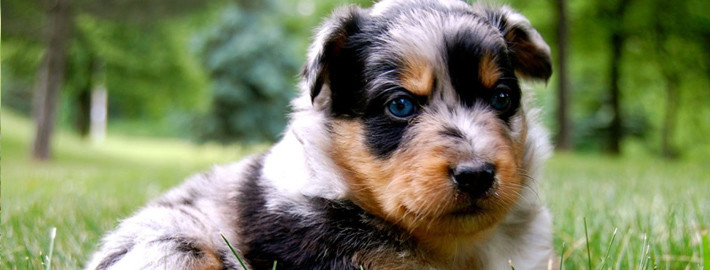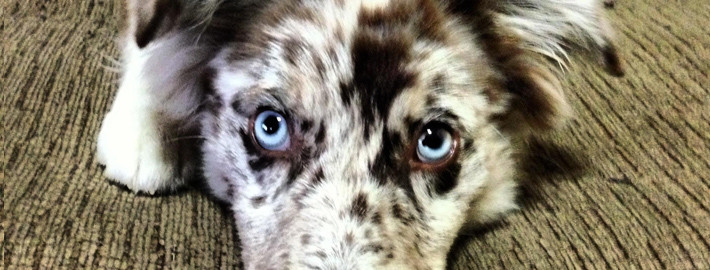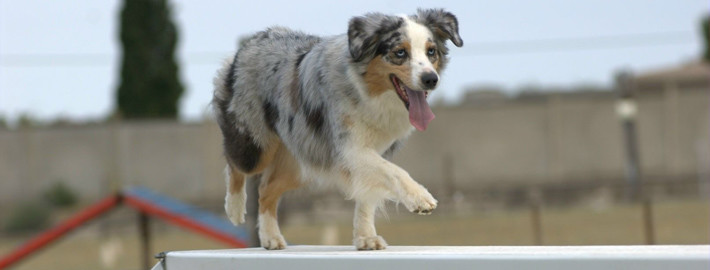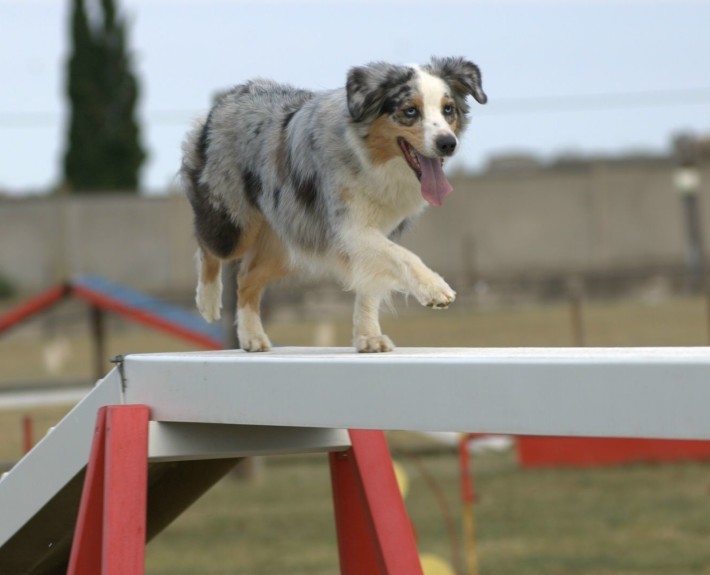What makes the Australian Shepherd Unique?
This is an athletic dog of medium size and bone; it is lithe, agile and slightly longer than it is tall. It is muscular and powerful enough to work all day, without sacrificing the speed and agility necessary to cope with bolting livestock. Its gait is free and easy, and it must be able to change direction or speed instantly. Its double coat is weather resistant, with the outer coat of medium texture and length, straight to wavy. The expression is keen, intelligent and eager.
The Australian shepherd has a great deal of stamina and is loving, bold, alert, confident, independent, smart and responsive. If it doesn’t get a chance to exercise and challenge its strongly developed mental and physical activities, it is apt to become frustrated and difficult to live with. With proper exercise and training, it is a loyal, utterly devoted and obedient companion. It is reserved with strangers and has a protective nature. It may try to herd children and small animals by nipping.
Breed Groups
Page Contents
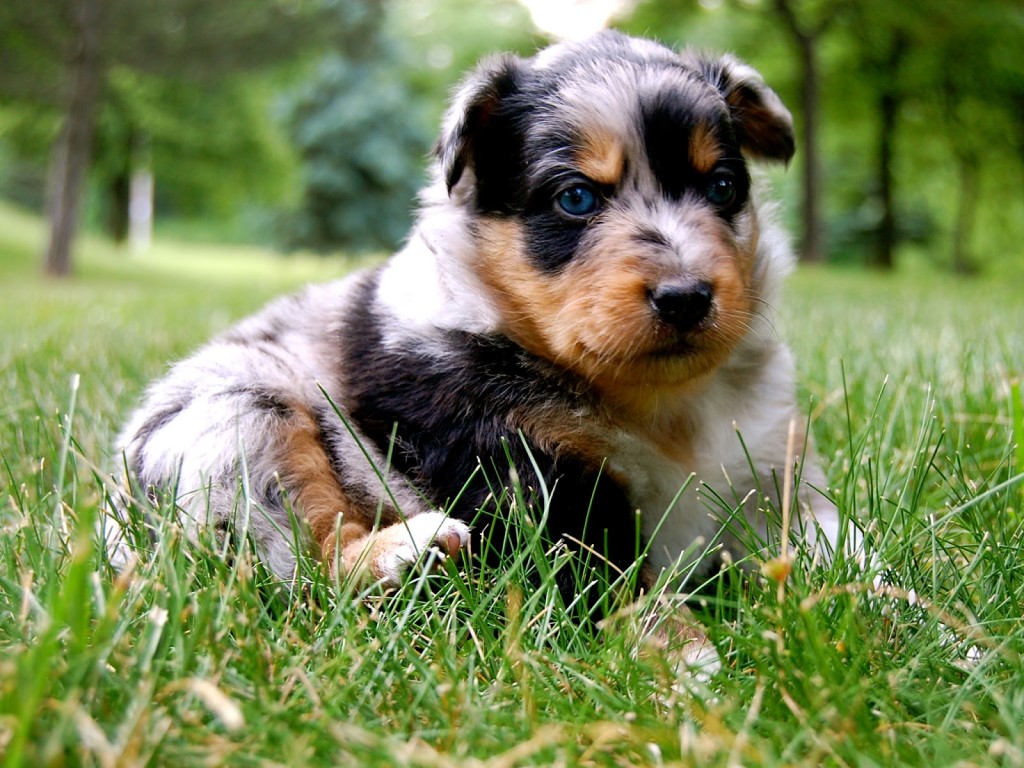
SnapShot
| Size: | Males – 51 to 58 cm (20 to 23 inches) Females – 46 to 54 cm (18 to 21 inches) |
| Weight: | Males – 25 to 31.8 kg (55.1 to 70.1 pounds) Females – 15.9 to 25 kg (35.1 to 55.1 pounds) |
| Origin: | United States of America |
| Life Span: | 13 to 15 years |
| Colour: | Red Merle, Red tricolor, Merle, Red, Black tricolor, Blue Merle, Black |
| Litter Size: | 6 to 9 puppies, 7 being the most common |
Is the Australian Shepherd Right For You?
The Australian shepherd has a great deal of stamina and is loving, bold, alert, confident, independent, smart and responsive. If it doesn’t get a chance to exercise and challenge its strongly developed mental and physical activities, it is apt to become frustrated and difficult to live with. With proper exercise and training, it is a loyal, utterly devoted and obedient companion. It is reserved with strangers and has a protective nature. The dog has had many names in the past including the Pastor Dog, Blue Heeler, Spanish Shepherd, Bob-Tail, New Mexican Shepherd and California Shepherd. Its many talents include retrieving, herding, watchdog, guarding, police work, narcotics detection, search & rescue, agility, competitive obedience and performing tricks.
In 5 Words
- Protective
- Good-Natured
- Active
- Intelligent
- Affectionate
Characteristics
Learn About the Australian Shepherd
Description
Australian Shepherds are vigorous, well-proportioned and rustic dogs—a little longer than tall. Their slightly domed heads and medium-length muzzles are about the same length, with almond-shaped eyes that can be blue, brown or amber. Their ears are triangular and set high, their chests are deep and their tails are straight and naturally short. They have a weather-resistant coat with a moderate texture, creating a little bit of a mane. Their hair is short and soft around the head, ears and front legs. Australian Shepherds can be found in black, blue merle, red merle, solid-red or red with white and/or tan markings. Overall, Australian Shepherds have strong, square, balanced frames.
Short History of the Australian Shepherd
The Australian shepherd is a breed of herding dog that was developed on ranches in the western United States. Despite its name, the breed, commonly known as an Aussie, did not originate in Australia and is American. In Australia, a Border Collie or Kelpie is more commonly used to herd sheep. They acquired their name because some of these dogs were used to herd Australian sheep. The breed rose gradually in popularity with the boom of western riding after World War I. They became known to the general public through rodeos, horse shows, and through Disney movies made for television.
Temperament
Australian Shepherds are easy-going, remaining puppy-like even in their adult years. This courageous dog makes a good watchdog for the home. Aussies are excellent with children, even with an active child, as they love to play. A devoted, loyal friend and guardian, for they are naturally protective. Affectionate, very lively, agile and attentive – they are eager to please, with a sixth sense about what the owner wants. Australian Shepherds are highly intelligent and easy to train. Though aggressive when at work with livestock, the Aussie is gentle with human friends. Australian Shepherds are not the kind of dog to lay around the living room all day or live happily in the backyard with only a 15 minute walk. They need much more exercise than that and something to occupy their mind daily or they will become bored, leading to serious behavior problems. Without enough mental and physical exercise and or a lack of a true pack leader, they can become nervous and destructive if left alone. Socialize well to prevent them from becoming suspicious of strangers. Working lines may be too energetic for people who only have a moderately active lifestyle. Some like to nip people’s heels in an attempt to herd them, and this behavior needs to be corrected teaching the dog that humans are not to be herded. The Aussie is a quiet worker. This breed is not usually dog aggressive.
Caring for Your Australian Shepherd
Grooming & Bathing
The Australian Shepherd or “Aussie” is a herding dog. Herding dogs have a high energy level and are very intelligent so they need a job so they do not get bored. The Aussie has a medium dense double coat and needs to be groomed every 4 – 8 weeks, with more frequent grooming during the shedding seasons of spring and fall when they change coats. As long as the undercoat is removed the outer guard coat will provide shade for your dog.
Exercise & Training
Like other herding breeds, these dogs excel at many dog sports, especially herding, dog agility, frisbee, and flyball. Herding instincts and trainability can be measured at noncompetitive instinct tests. Aussies that exhibit basic herding instincts can be trained to compete in ASCA stock dog trials or AKC herding events.
The dog has a stride in which its front and back legs cross over, making for an appearance of “on the edge” speed. The dogs instinctively use a “pounce” position to deal with cattle trying to kick them. They also have strong hips and legs, allowing for fast acceleration and high jumping, sometimes as high as 4 ft (1.3m).

